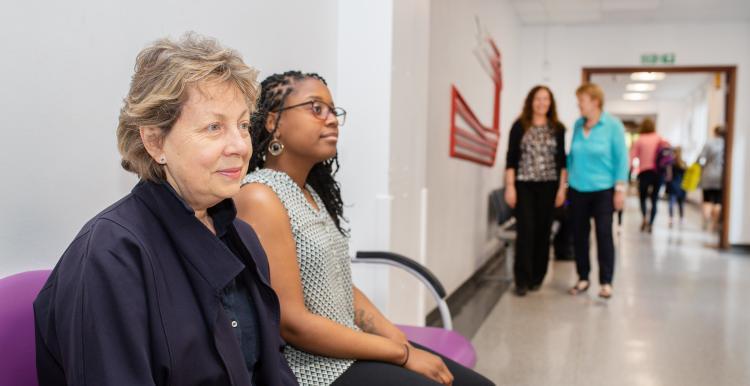NHS buildings - patient stories

Ageing buildings
Patient wellbeing does not solely lie in the hands of doctors and other frontline staff. The built environment – room layout, light, indoor temperature, and signage, to mention a few – can also contribute to people’s experience of healthcare and affect their safety.
According to NHS data, estate and infrastructure failures in England disrupted the care of more than 2,600 patients. The risks of ageing buildings have been widely reported in the media, with the total repairs backlog for the NHS at £11.6bn last year.
The King’s Fund thinktank has recently published an analysis of productivity in the NHS which shows that one of the key factors behind a very slow growth in productivity is: “ the lack of investment in capital and technology which means staff are working with outdated equipment in buildings that are not fit for purpose”.
Healthwatch research
Earlier this year, NHS England asked Healthwatch to help them understand what patients and the public wanted to see improved in NHS buildings. To do this Healthwatch looked at the experiences people shared.
Healthwatch England based the analysis on:
- people’s feedback received via our webform and local Healthwatch, respectively;
- reports from regular Enter and View visits to health and care facilities by Healthwatch staff and volunteers.
Key findings
- Buildings are not accessible to disabled people.
- Hard-to-follow and inaccurate signage confuses patients and other visitors.
- Old buildings are poorly maintained, while some new buildings are badly designed.
- Lack of parking facilities.
- While significant work is needed to improve NHS buildings, patients and the public often share their views around lower-level issues, which requires vital investment in the NHS estate.
Inaccessible and poorly signed buildings
The NHS is bound by Equality Act duties to ensure its services are accessible to disabled people. Despite this, buildings that aren't accessible to people with additional needs are a common theme that we hear about. Many people, especially those visiting dental practices, tell us they can't access buildings by wheelchair.
"When I arrived for my appointment, I found that they do not have level access to the practice, therefore I couldn't get into the building in my wheelchair; they seemed surprised that I couldn't get in as they had been inspected by the GDC who approved their accessible status." Story about a dental practice visit from Healthwatch Hertfordshire
Signage is frequently mentioned as a severe barrier to good access to services. People tell us about both incorrect and difficult-to-follow signage. Poor signage can lead to people running late for appointments, causing confusion or adding to the worry often associated with hospital visits.
"Find the signage very difficult to follow, as there are no ward or department names listed on floor signs, just numbers. You need to know the code for the department you’re visiting.” Story shared with Healthwatch England
Badly designed or poorly maintained buildings
We hear a lot about buildings in a poor state of repair.
“The A&E department building is very old and lacks basic facilities” .
“The layout is disjointed; even the new areas look uncared for. There are no nice facilities; we need seats in corridors due to the distances." Stories shared with Healthwatch England.
We often hear about cramped and unsuitable waiting rooms and wards. For example, one patient said: "Cramped, hot and very uncomfortable waiting room. Seats too close to each other." Story shared with Healthwatch England.
Patients also raise issues with cold and uncomfortable waiting rooms, which require investment. Quotes include, "I spent one night on the most uncomfortable chairs in the world." Story shared with Healthwatch Harrow.
Parking and access to NHS sites
There is guidance issued by the Government to the NHS about car parking and sustainable travel. Despite this, we often hear about parking and sustainable transport, particularly the issues created when parking is necessary to access care but is unavailable.
“The distances involved and lack of staff to help make the hospital a disabling environment for frail, elderly, disabled or infirm people. This is the definition of most of the people that need to visit. Parking is appalling, yet there is very limited public transport.” Story shared with Healthwatch England.
Local Healthwatch conducting Enter and View visits sometimes encounter a lack of accessible parking and drop-off facilities at GP practices. For example, Healthwatch Gloucestershire found during a visit to a GP in Gloucester, “There are no designated disabled parking bays or drop-off points at either [GP Practice] site for a GP visit.”
What can be done to improve NHS buildings?
Based on the feedback collated from local Healthwatch and Healthwatch reports, Healthwatch England set out the following recommendations for the Government and NHS England:
-
Create a new accessibility standard for new NHS buildings. We have heard that health facilities often do not meet the needs of patients and visitors, whether there is limited or remote accessible parking or not all treatment areas are wheelchair accessible.
The NHS should create a best-practice accessibility standard for all significant building projects. It should include updated guidance on the sufficiency of accessible parking, high standards for waiting and patient areas (including around issues such as temperature), and requirements linked to digital developments such as access to Wi-Fi and charging ports.
- Flexible, local infrastructure investment. While some people tell us that major building work is needed, common themes highlight the need for relatively minor changes that can make a big difference to patients. The NHS and Department for Health and Social Care should consider allowing swift local decision-making on small capital programmes to allow facilities to respond to local people’s needs.
- The NHS should improve transport facilities. Healthwatch receives much feedback on issues such as accessing NHS facilities, from poor public transport links to expensive and limited parking to buildings that are not easily accessible from car parks. The NHS must help answer these interlinked issues, whether by improving public transport access within a site or redesigning car parking to be closer to waiting rooms.

